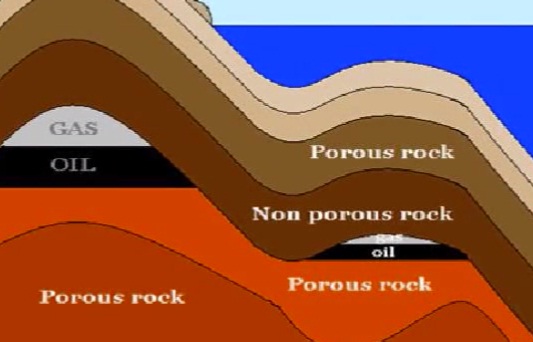Petroleum reservoirs exist in many different sizes and shapes of geologic structures. It is usually convenient to classify the reservoirs according to the conditions of their formation as follows:
1. Dome-Shaped and Anticline Reservoirs:
These reservoirs are formed by the folding of the rock layers as shown in Figure 1. The dome is circular in outline, and the anticline is long and narrow. Oil and/or gas moved or migrated upward through the porous strata where it was trapped by the sealing cap rock and the shape of the structure.
2. Faulted Reservoirs:
These reservoirs are formed by shearing and offsetting of the strata (faulting), as shown in Figure 2. The movement of the nonporous rock opposite the porous formation containing the oil/gas creates the sealing. The tilt of the petroleum-bearing rock and the faulting trap the oil/gas in the reservoir.
3. Salt-Dome Reservoirs:
This type of reservoir structure, which
takes the shape of a dome, was formed due to the upward
movement of large, impermeable salt dome that deformed and
lifted the overlying layers of rock. As shown in Figure 3,
petroleum is trapped between the cap rock and an underlying
impermeable rock layer, or between two impermeable layers of
rock and the salt dome.
4. Unconformities:
This type of reservoir structure, shown in Figure 4, was formed as a result of an unconformity where the
impermeable cap rock was laid down across the cutoff surfaces of the lower beds.
5. Lense-Type Reservoirs:
In this type of reservoir, the petroleum bearing porous formation is sealed by the surrounding, nonporous formation. Irregular deposition of sediments and shale at the time the formation was laid down is the probable cause for this abrupt change in formation porosity.
6. Combination Reservoirs:
In this case, combinations of folding, faulting, abrupt changes in porosity, or other conditions that create the trap, from this common type of reservoir.
Reservoir Drive Mechanisms
At the time oil was forming and accumulating in the reservoir, the pressure energy of the associated gas and water was also stored. When a well is drilled through the reservoir and the pressure in the well is made to be lower than the pressure in the oil formation, it is that energy of the gas, or the water, or both that would displace the oil from the formation into the well and lift it up to the surface. Therefore, another way of classifying petroleum reservoirs,
which is of interest to reservoir and production engineers, is to characterize the reservoir according to the production (drive) mechanism responsible for displacing the oil from the formation into the wellbore and up to the surface. There are three main drive mechanisms:
I. Solution-Gas-Drive Reservoirs:
Depending on the reservoir pressure and temperature, the oil in the reservoir would have varying amounts of gas dissolved within the oil (solution gas).
Solution gas would evolve out of the oil only if the pressure is lowered below a certain value, known as the bubble point pressure, which is a property of the oil. When a well is drilled through the reservoir and the pressure conditions are controlled to create a pressure that is lower than the bubble point pressure, the liberated gas expands and drives the oil out of the formation and assists in lifting it to the surface.
Reservoirs with the energy of the escaping and expanding dissolved gas as the only source of energy are called solution-gas-drive reservoirs.
This drive mechanism is the least effective of all drive mechanisms; it generally yields recoveries between 15% and
25% of the oil in the reservoir.
II. Gas-Cap-Drive Reservoirs:
Many reservoirs have free gas existing as a gas cap above the oil. The formation of this gas cap was due to the presence of a larger amount of gas than could be dissolved in the oil at the pressure and temperature of the reservoir. The excess gas is segregated by gravity to occupy the top portion of the reservoir.
In such a reservoirs, the oil is produced by the expansion of the gas in the gas cap, which pushes the oil downward and fills the pore spaces formerly occupied by the produced oil. In most cases, however, solution gas is also
contributing to the drive of the oil out of the formation.
Under favorable conditions, some of the solution gas may move upward into the gas cap and, thus, enlarge the gas cap and conserves its energy. Reservoirs produced by the expansion of the gas cap are known as Gas-cap-drive
reservoirs. This drive is more efficient than the solution-gas drive and could yield recoveries between 25% and 50% of the original oil in the reservoir.
III. Water-Drive Reservoirs:
Many other reservoirs exist as huge, continuous, porous formations with the oil/gas occupying only a small portion of the formation. In such cases, the vast formation below the oil/gas is saturated with salt water at very high pressure. When oil/gas is produced, by lowering the pressure in the well opposite the petroleum formation, the salt
water expands and moves upward, pushing the oil/gas out of the formation and occupying the pore spaces vacated by the produced oil/gas. The movement of the water to displace the oil/gas retards the decline in oil, or gas pressure, and conserves the expansive energy of the hydrocarbons.
Reservoirs produced by the expansion and movement of the salt water below the oil/gas are known as water-drive
reservoirs. This is the most efficient drive mechanism; it could yield recoveries up to 50% of the original oil.
References:
Petroleum and Natural Gas Field Processing -H. K. Abdel-Aal and Mohamed Aggour

